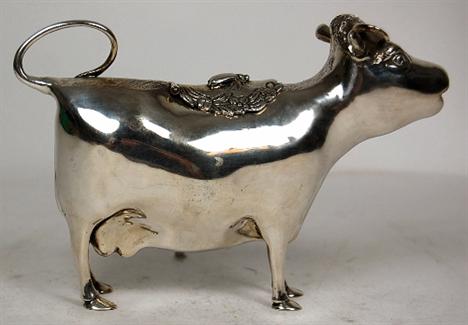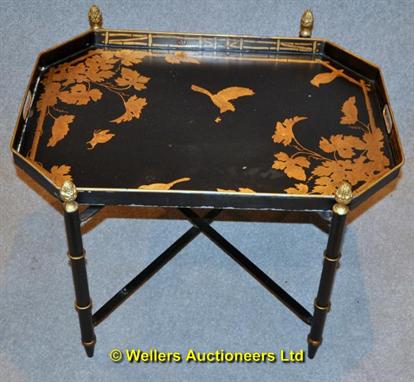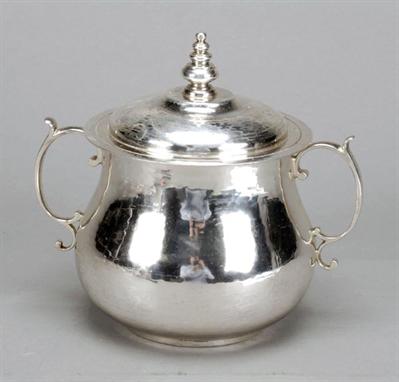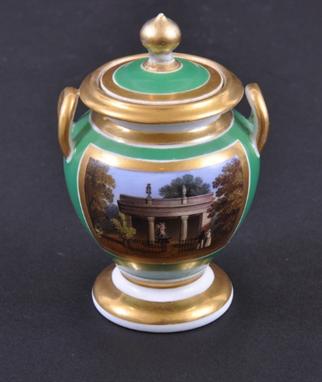We found 116041 price guide item(s) matching your search
There are 116041 lots that match your search criteria. Subscribe now to get instant access to the full price guide service.
Click here to subscribe- List
- Grid
-
116041 item(s)/page
A CHAMBERLAIN'S (WORCESTER) CRESTED ICE-PAIL, COVER AND LINER CIRCA 1805-10, BLACK PRINTED MARK The cover with gilt dolphin finial, a pierced gallery to the rim, painted with the crest of a soldier with flaming torch and motto 'Virtus Invicta Gloriosa', on a salmon-pink ground gilt with foliate design, applied with two shell handles (3) View on Christie's.com
A SILVER COFFEE POT AND HOT WATER JUG IN THE EARLY 18TH CENTURY STYLE MARK OF J. PARKES AND CO., LONDON, RESPECTIVELY 1929 AND 1925 Each with plain tapering sides and double knop finial; also a small silver two-handled tray by Charles Clement Pilling, London, 1903, gadroon borders with shell and foliate corners The coffee pot, 9 3/8 in. (23.8 cm.) high; the tray, 22¼ in. (56.5 cm.) long 112 oz. (3,472 gr.) (3) View on Christie's.com
A GEORGE IV SILVER MATCHED THREE-PIECE TEA SET THE TEAPOT, MARK OF JOHN JAMES KEITH, LONDON, 1826, THE CREAM JUG AND SUGAR BOWL, MAKER'S MARK INDISTINCT, LONDON, CIRCA 1825 Squat circular, the fluted sides centred by crested foliate cartouches, scroll borders interspersed with flowerheads, on four foliate shell feet, the teapot with ivory insulators to handle and finial The teapot, 6 in. (15.3 cm.) high 48.5 oz. (1,504 gr.) (3) View on Christie's.com
THREE SILVER-PLATED KETTLES ON STANDS SECOND HALF OF 19TH CENTURY Comprising one Victorian example by Martin Hall & Co., circa 1875, with engraved decoration, the spirit stand with pierced sides, another of squat circular melon-fluted form with engraved scrollwork and seated Chinaman finial, crested, circa 1860 and a Continental example with ivory grip and gilt leafy pod finial, cover engraved with coronet and initials, circa 1880 Tallest 17¼ in. high (44 cm.) (3) View on Christie's.com
2 rare Bing ‘O’ gauge tinplate Train Indicators. A black column surmounted with a clock and finial with ‘Next Train To’ facility and 6 destination boards in lower racks, showing for example ‘Leicester-Derby-Manchester’. Secured to a square brown base. Also a black coloured board and cupboard type Train Indicator, with four platform positions, clocks and destination boards, showing for example ‘Trent’. GC-VGC. Plate. 3
A set of six Victorian Baronial oak side chairs each with floral carved top-rail and cushioned back flanked by barley sugar twist supports over a green cushioned seat with shaped apron raised on carved tapering octagonal legs terminating in bun feet and united by shaped X-frame stretchers mounted with a central urn finial (6)
A Late Victorian mantle clock William Comyns, London 1899, retailed by Edwards and Sons Glasgow, the dial with Roman numerals with swag and floral pendant decorations, the full silver case with scrolling borders and embossed courtly and landscape scenes, with presentation inscription to front, the whole raised on open bracket feet and with urn finial 32cm high
An interesting unmarked scent bottle the fluted body with traces of gilding, the screw off cover with loop finial, engraved to base MR in script within foliate surround; together with a late Victorian box, of simple cylindrical form with presentation inscription and the pull off cover embossed with a winged figure (2) scent 5cm high
A silver plated serving dish stand and burner of rectangular outline with simple beaded border and loop handles, with slightly domed cover and square finial, raised on simple frame with reeded supports and centrally fitted spirit burner; together with a plated tankard, pair of comports and sugar basket (5)
A Continental, probably French wrought iron lenticular lamp, first half 19th century, of typical form with swing handle above the cushion form reservoir, the filling plate with cockerel finial, 26.5cm high including hanging attachments, 12.5cm wide. Comparative Literature: Cf. John Caspall, Making Fire and Light in the Home pre-1820, Antique Collectors’ Club, 1987. See p221 for a very similar example. Lamps of this type were produced throughout Continental Europe, probably for mining use.
A Meissen garniture de chiminee of three baluster vases and covers and two beaker vases, painted with chinoiserie panels of oriental figures within bold brown and gilt ombrierte cartouches in the manner of P.E. Schindler, each surrounded by scattered sprays of deutsche Blumen, the central vase and cover, 54cm high, blue crossed swords marks (cover finial repaired), the two smaller baluster vases and covers, 45cm and 46cm high, blue crossed swords marks (one finial restored and one with restored area to neck rim), the beaker vases, 41.5cm and 42cm high, probably late 19th century. On the instructions of the Administrators of Partridge Fine Art Ltd (in Administration).
A Victorian silver oval half reeded teapot by Charles Stuart Harris, London 1888, with composition lobed finial and harp shaped handle, on a collet foot, engraved with a crest and legend ‘Nobilis est ira leonis’, 24.5cm, 9.75in long, 510g (16.6oz) gross. The crest and motto of this teapot belongs to the name of Stuart, kinsman of the Marquesses of Bute who use this crest and motto along with another crest and motto for CRICHTON. The first husband of Mrs Knatchbull-Hugessen (Ropley House) was Lord James Charles Crichton-Stuart, son of Sir John Crichton-Stuart, 5th Marquess of Bute and Lady Eileen Beatrice Forbes. In 1947 ownership of Dumfries House passed to Sir John Crichton-Stuart,5th Marquess of Bute and upon his death in 1956, the Dowager Marchioness of Bute returned to live at Dumfries House.
A William IV silver three piece tea set by Edward, Edward Jr, John and William Barnard, London 1835, the compressed circular bodies with shaped, everted rims and engraved with scrolls, foliage and trellis work panels between mainly vacant cartouches, of a teapot with sprung domed cover to a whippet finial, engraved with a crest and initials TJC?, a two handled sugar basin with gilt interior, and a cream jug, the teapot 27.5cm (10.8in) long, 1395g (44.85oz) gross
James Glass, Bristol, a mahogany moon-phase longcase clock, the eight-day duration movement striking the hours on a bell, with the thirteen-inch painted arched dial having black Roman numerals, cottage scenes painted to the four corners, a seconds dial and date aperture, with boxwood and decorative brass hands, the arch having a moon-phase date disc, the mahogany case having a short door with barley-twist columns to the trunk and boxwood & ebony stringing and inlay to the base & trunk, the hood with wavy moulding to the frame, barley twist columns with cast brass capitals, wavy-top cresting and eagle finials, height: 220cms (inc. finial) * James Glass, is recorded as working at 31, Old Market Street, Bristol from at least 1825 until 1856 and married Ann Brooks on the 6th of March 1825 at St. Philip & Jacob Church. He was paying insurance premiums on six houses in Bristol & Somerset and was still renewing in 1856 obviously supplementing his clockmaking business by buying, selling and renting property.
A George III silver tea caddy, of serpentine form, having allover embossed and engraved floral decoration, the hinged lid surmounted by a fruit and floral finial above lock plate and cartouche with armorial, (possibly Newcastle 1782), 14cm wide x 11.5cm high, approx. 16ozs., AF - see illustration
A Vienna porcelain lidded bowl of gilt heightened dark blue ground, the lid with typical polychrome panel depicting a couple in sylvan landscape and the interior decorated with floral sprays (15cms dia), a small Dresden porcelain baluster shaped vase of gilt heightened pink/white ground with typical floral and figural panels (21cms, as viewed, lid finial repaired) and a glass cylindrical vase with engraved floral border.
A William IV three-piece silver tea set, by Barnards, London 1836-37, of shouldered and tapering form, chased and engraved floral decoration, with scrolls and foliage, blank cartouches, comprising a teapot, with hinged domed lid, flower finial, fluted scrolled handle and spout, scrolled feet, 16cms, (6½"), two-handled sugar bowl, milk jug, 38ozs in total, (3).
A matched five-piece silver tea service, by Garrards, London 1899, 1901, 1882 and 1900, compressed pear-shaped form, comprising teapot with domed lid, hardwood handle and finial, 17cms, (6¾"), milk jug, crested 9cms, (3"), cream jug, crested, 7cms, (2¾"), a spirit kettle on stand with burner, swing handle, the stand on three baluster supports, 38cms, (15") overall, together with a sugar bowl by Stokes & Ireland Ltd., London 1914, 106ozs in total in a fitted oak carrying case, labelled "Heming & Co. Ltd., Conduit Street, London".
A George III silver tea urn, by John Emes, London 1807, the circular urn with a waisted neck supported on four leaf capped paw supports, resting on a shaped square base on ball feet, the reeded spigot with an ivory handle, the detachable domed cover with a compressed ball finial, with gadroon borders and lion mask ring handles, engraved with coat of arms and crest, 37 cm high, approximately 140oz. The arms of SIBTHORP quartering WALDO impaling (?) SUTTON for a descendant of Col. HUMPHREY SIBTHORP, MP (1744-1815) of Canwick Hall, Lincolnshire. Colonel Sibthorp declined a baronetcy, but in 1804 assumed by Royal Warrant the additional name and arms of WALDO in grateful remembrance of an ancestor. The name Sibthorp is inextricably linked with plant science at Oxford University where an earlier Humphrey Sibthorp, who married Sarah Waldo, and their son John were both Professors of Botany.
-
116041 item(s)/page
























































